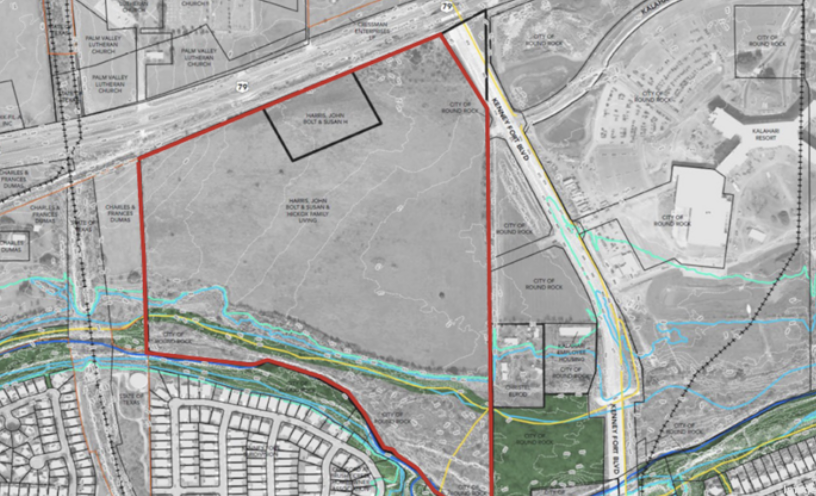(Article is from Austin Business Journal, copyright belongs to owner)
An Indiana mixed-used developer is poised to invest as much as $300 million into a 110-acre project located in an entertainment and tourism region near Dell Diamond in Round Rock.
Milhaus, which is based in Indianapolis, will bring its informally titled Kenney Fort North PUD project to the Round Rock City Council next month after the city’s Planning and Zoning Commission recommended approving a rezoning to allow a mix of multifamily residences and townhomes, retail, a maker space and park space on a lot near East Palm Valley and Kenney Fort boulevards.
While the specifics of the project are still being finalized, Brad Vogelsmeier, vice president of development for Milhaus, said the first phase will include 350 market-rate apartments in addition to infrastructure and connections to the Brushy Creek Trail. They’re hoping to break ground early next year and open the first buildings in 18-24 months.
The entire project is scheduled to be completed over the next 5-7 years, and could bring as many as 1,500 housing units and a few-hundred thousand square feet of commercial space, Vogelsmeier said. He estimated the project will cost between $250 and $300 million.
“That’s genuinely what we’re envisioning right now, but we’re not fully committed to one specific plan right now,” he said. “This is a big way to dip our toe in Austin. … Our hope is to expand into the market more broadly once we start on this project.”
Round Rock economic development leaders have been aiming to build higher in the suburb just north of Austin, as density becomes the name of the game throughout Central Texas.
The City Council last month approved the $200-million-plus, 65.5-acre The District project, which is set to break ground this summer and bring 3 million square feet of office space, 1,600 multifamily units, a 250-room hotel, 230,000 square feet of retail and walkable and bikeable open spaces over the next decade to a location near I-35 and State Highway 45. The District will be across the highway from Dell Technologies Inc.’s headquarters.
The Council also has approved a housing project less than two miles away from the Kenney Fort project for up to 375 single-family homes as part of a repurposing of the site of Camp Doublecreek.
Milhaus has more than 20 projects across the country, including Indiana, North Carolina, Tennessee and Missouri. The company recently announced their first project in Texas, a $55 million, 279-unit luxury multifamily community in Dallas called Banyan Buckley.
For their first Austin project, they are seeking to rezone the property, located across the street from the Kalahari Resort and less than a mile from the baseball stadium, from business park to the planned unit development with greenfield and large lot designation. It is expected to be on the agenda in the first meeting in August.
The project team also includes ArchCo Residential, which is handling the residential mixed-use development and Lionheart Places, the land planner, urban designer and landscape architect. Amanda Swor, director of entitlements and policy at Drenner Group PC, is the project representative.
The developers were drawn to the area because of its proximity to what Vogelsmeier called “entertainment tourism” near the baseball stadium, resort and hiking trails, as well as its overall location adjacent to Austin and an employment anchor in Dell.
The project will ultimately include a mix of apartments and townhomes, retail, maker and office spaces and a hotel, Vogelsmeier said. The maker space designation was included to offer a cost-effective way to deliver industrial space. Retail is imagined as service-oriented and local and regional shops. They’re also hoping to attract a small-format grocer.
The property would include retail, office and hotel space (10-50%), urban-style multifamily residences (20-60%), mixed residential (0-30%), and single-family and townhouses (20-40%), according to city documents. A total of 25 acres of the property would be designated for parks and open space.
“It’s really difficult to find tracts of this size to do a project this unique within a growing MSA like Austin,” Vogelsmeier said. “As this area of Round Rock grows, we think the commercial viability will become stronger and stronger and stronger.”
The property does have a number of “natural barriers,” Vogelsmeier said. Developers previously acknowledged the site is 96% constrained in some way by railroad tracks to the north, a flood plain to the south and other fencing. Entrance to the property is currently only available off Kenney Fort Boulevard.
But Vogelsmeier said they’ve been spending time to discuss sensitivity about how commercial developments will work on the site, and that they’ve been inundated with interest from both commercial and residential users.
He said he believes the project will ultimately appeal to a wide-ranginge demographic, with the flexibility for those might want to age in place in townhomes, market-rate apartments that would attract younger people, and families who would love the proximity to walking trails and the water park next door.
“You get quite a bit of an array with some of the stuff we’re trying to do,” he said. “I don’t think there’s one demographic that this solely caters to.”


